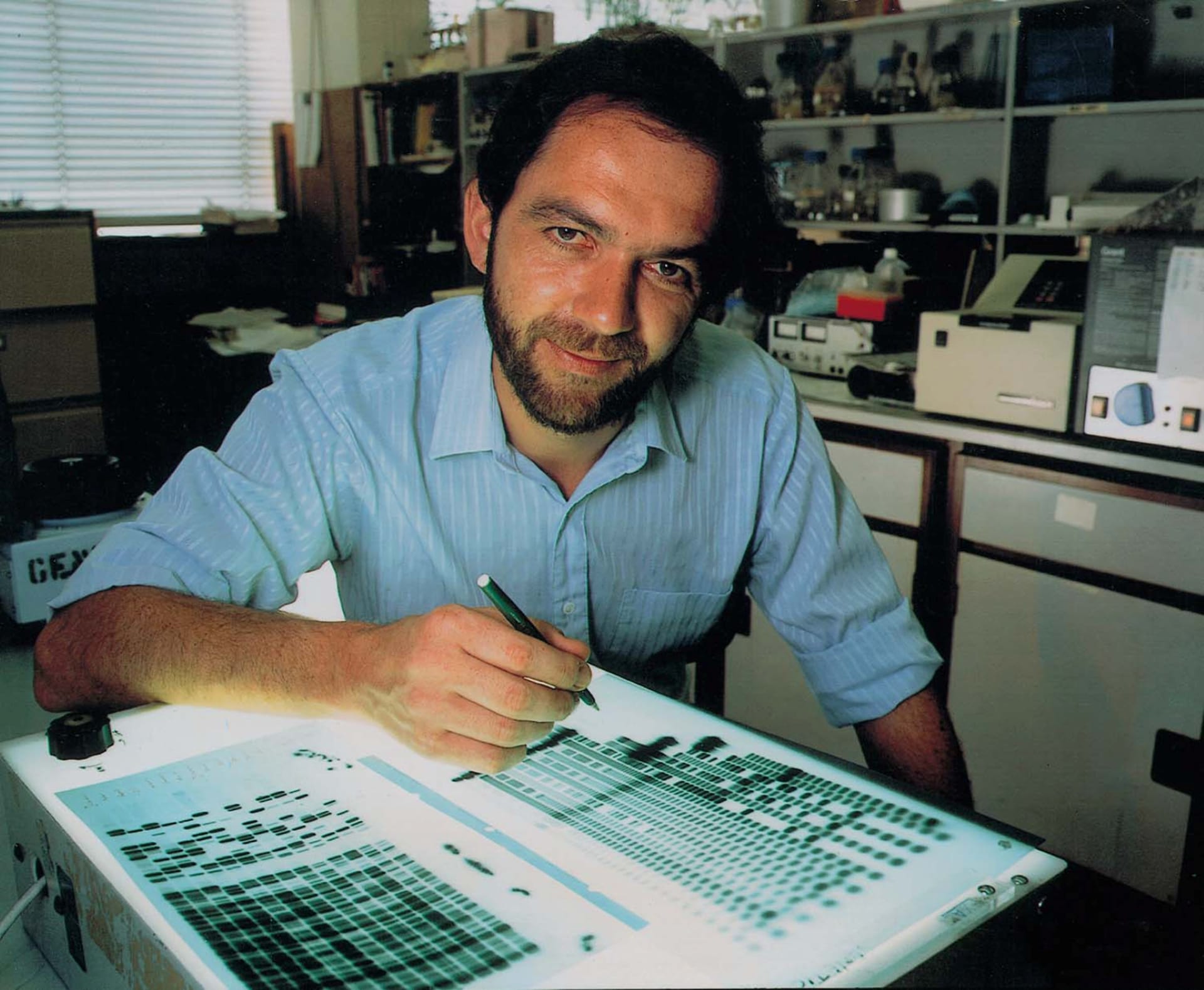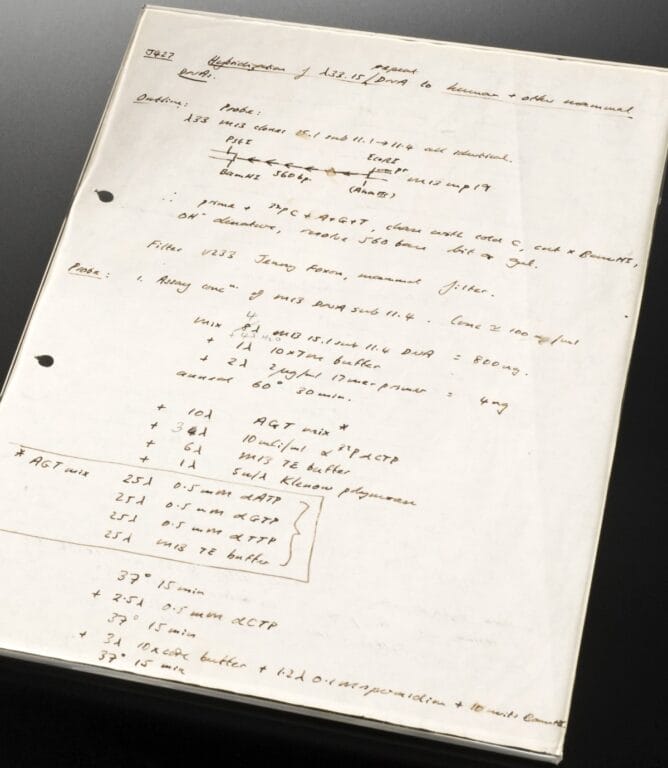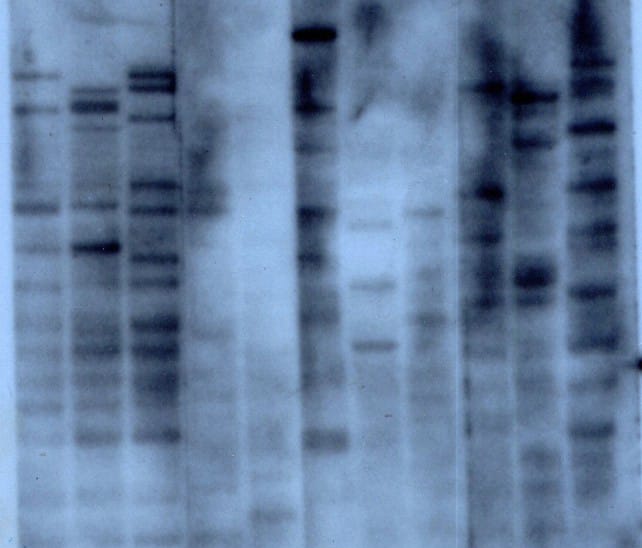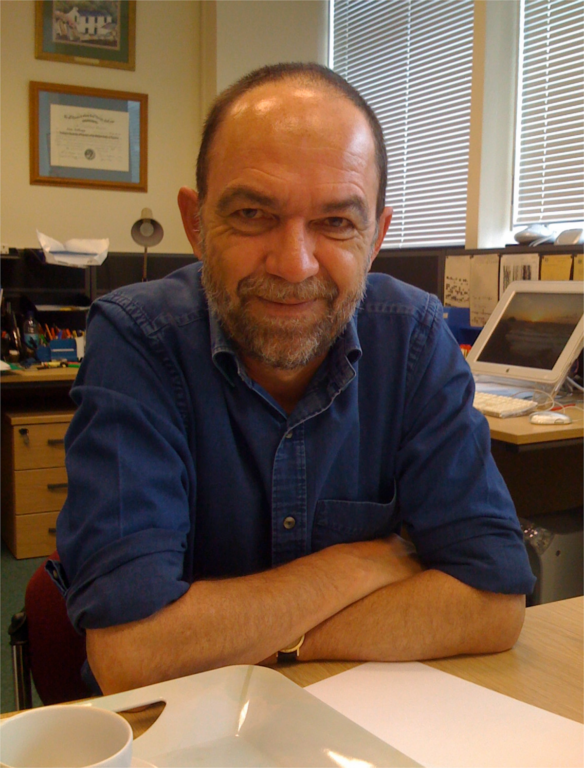The dawn of DNA profiling: the ‘eureka’ moment that revolutionised crime solving

In 1984, Alec Jeffreys developed the technique of DNA fingerprinting in his laboratory at the University of Leicester. These techniques have revolutionised the way that the police solve crimes.
Key terms
DNA
(deoxyribonucleic acid) A molecule that carries the genetic information necessary to build and maintain an organism.
Genome
The complete set of genetic instructions required to build and maintain an organism.
- On average, about 99.9% of the DNA between two humans is the same. The remaining 0.1% might not sound like much – but that’s around 3 million bases that can differ between two people.
- Alec Jeffreys developed DNA fingerprinting – a technique to compare these differences and produce a pattern that’s unique to an individual.
- This revolutionised the way crimes were solved, by making it possible to routinely analyse biological samples.
Investigating our unique genetic code
From a young age Alec Jeffreys was fascinated by science and the world around him. Aged eight, he received his first chemistry set and from then on, he was always experimenting.
Fast forward 19 years and Alec was leading his own – albeit small – genetics laboratory at the University of Leicester. It was the 1970s, and an exciting time for science. Alec had considerable freedom in his lab and made full use of it, often staying at the lab long into the small hours.
Alec and his team were studying inherited variation, focusing on the DNA itself. As humans, we share around 99.9 per cent of the same genetic material – but Alec was interested in the remaining 0.1%, the part that contains our unique genetic code.
Alec wanted to find this code and understand it. But to do so was like looking for a single letter difference in two, otherwise identical, books.

Alec identified a repeating sequence of DNA called a ‘minisatellite’.
Homing in on minisatellites
Alec started by examining the DNA sequence found in the myoglobin gene of seals.
Myoglobin is an oxygen-binding protein found in muscle tissue. It’s found in almost all mammals, including humans and mice. For diving animals like seals and whales, it’s essential for swimming to great depths to feed while holding oxygen in their bodies for long periods of time.
Within the DNA sequence of the seal myoglobin gene, Alec identified a length of DNA that repeated itself in the sequence. He realised that these regions of DNA were unique to an individual and could be used to distinguish one seal from another.
This led him to ask: could similar sequences in humans be used to distinguish one person from another?
The scientific name for these repeats is a ‘minisatellite’ – short, repetitive lengths of DNA, about 10 to 60 bases long, that occur at more than 1,000 places across the human genome. Minisatellites are highly variable and tend to differ from person to person, which means that by comparing minisatellites it is possible to identify a particular individual from their DNA.
To better understand these minisatellites, Alec tried to cut the DNA up into smaller and smaller pieces using specific enzymes called restriction enzymes. But time after time he came up against a wall – the enzymes weren’t cutting the DNA as much as he hoped. This meant he couldn’t get a clear picture of the repeating regions.


Minisatellites are short, 10-60 base pair sequences of repetitive DNA that show greater variation from one person to the next than other parts of the genome.
Eureka!
Alec had a saying ‘every failure leads to success’ – so he kept on working.
He decided to try something different based on his knowledge of the myoglobin gene. He took a DNA sample from one of his lab technicians and placed it alongside DNA from each of their parents, as well as the DNA from a tobacco plant, a cow and a seal.
He added radioactively labelled probes – short segments of DNA that only bind to the DNA sequence of interest – that would help him to recognise the myoglobin gene. When the probe binds to the DNA, it highlights it as a black blob.
Using this probe approach, at 9.05am, on 10 September 1984 – Alec finally had this eureka moment.
The probe had bound to all the minisatellite sequences with a similar sequence to the probe, resulting in a completely different pattern of dark bands, unique to the individual. The technician shared parts of their pattern with their mother and father showing that they were related. In contrast, the tobacco, cow and seal all had completely different patterns, showing that they were not related at all.
Finally, the penny dropped. Alec realised he had produced the first DNA fingerprints.


Probes are small fragments of DNA tagged with radioactive phosphorous that only attach to complementary pieces of DNA in the genome.
Bringing families back together
The news of Alec’s accidental eureka moment soon reached the press.
In 1985, Alec was approached to help with an immigration case by a lawyer who had read about DNA testing in The Guardian. The lawyer was representing a Ghanaian family, the mother of which had been living in the UK for some time with two of her children. Her remaining child had recently arrived in Britain but had been accused of having a fake passport – and was at risk of being sent back to Ghana.
After discussions with the lawyer, Alec took a sample of blood from the mother and each of the three children. He then extracted their DNA and compared their genetic fingerprints. The fingerprints proved that the boy was definitely the mother’s son – and that he was related to her other children.
As a result, the Home Office dropped the case, and the boy was permitted to stay in the UK with his family.
This was the first time a legal dispute was resolved with the help of results from a genetic test.
Investigating a murder
Just after midnight on 21 November 1983, a 15-year-old girl called Lynda Mann was reported missing in Narborough near Leicester. A few days later, her body was found on a deserted foot path, just 300 metres from her home.
The investigation into Lynda’s murder was led by Detective Chief Superintendent David Baker. He made a promise to Lynda’s mother that he would find the person who killed her daughter and moved his team into an unused building nearby in Narborough to help investigate the case.
A year later however, despite hundreds of leads, they were no closer to finding the killer.
On 31 July 1986 David received a call that Dawn Ashworth, another young girl, had been reported missing. Her body was later found in a wooded area – just like Lynda had been three years earlier.
Not long after Dawn was found, a local 17-year-old man claimed he had known the whereabouts of Dawn’s body before the police did. David and his colleagues arrested him, and he openly confessed to killing Dawn but claimed he had nothing to do with Lynda’s murder.
But something didn’t quite add up. Some of the details that had been given by the suspect didn’t fit with the crime scene of Dawn’s murder.
David felt that it was the same person who had murdered both children and was keen to find evidence to confirm or deny his suspicion. The police team had biological samples that were found on Lynda’s clothes that were believed to have come from the killer.
Surely there was a way to find out whether this suspect was responsible.
Genetics provides important answers
David got in touch with Alec after reading about the work with the Ghanaian family, using DNA analysis to resolve immigration issues. Alec wasn’t sure whether the biological samples collected from Lynda’s clothes, now three years old, would still be viable for DNA testing – but he was prepared to try.
A blood sample was taken from the suspect and compared to the crime scene samples. The results showed the suspect’s DNA was completely different from the sample found at the crime scene, adding evidence that the suspect hadn’t killed Lynda.
But was he responsible for Dawn’s murder? Alec carried out the same test, this time comparing the suspect’s samples with those taken from Dawn’s crime scene. Again, there was no match between the suspect’s DNA and that found on Dawn’s body. This suggested he hadn’t murdered either child – despite his confession.
The 17-year-old became the first person to have his innocence proven by DNA fingerprinting. Further analysis showed that the DNA samples from both crime scenes were the same – and that without a doubt, the same person had murdered both Lynda and Dawn.
The first DNA ‘manhunt’
According to research, serial killers tend to kill within a five-mile radius of where they live.
Spurred on by the effectiveness of Alec’s DNA fingerprinting test, David had a brilliant idea – to test the DNA from every man between the ages of 18 and 34 who lived within an 8-kilometre radius of where the bodies were found. This would be about 5,000 men in total. It would be labour-intensive, time-consuming, expensive and an entire new forensic facility would be needed.
But David was determined to find the killer before he had a chance to repeat his crime a third time.
Before they could go ahead with the DNA tests, they needed backing from the government. At over £100 for each blood test, they would need around £500,000. The Home Office was initially reluctant to pay but eventually, with the support of the Prime Minister Margaret Thatcher, the project was given the go-ahead.

The Home Office were initially reluctant to pay for the test – but the Prime Minister gave the go ahead.
A long process
Now they just had to invite local men to come forward for the tests. Anyone who refused to attend or ignored the invitation were visited by the police and asked why. Overall, however, turnout was good.
The team knew that the murderer had type A blood, so they’d only need to do a full test on people with type A blood – predicted to be around 20% of the samples collected. Even so, it was predicted to be a long process.
By the time 4,000 samples had been taken, and 3,000 men were cleared, the head of the police department started to have doubts as to whether the process was actually working. There were serious talks about stopping funding for the DNA investigation.
In addition, Alec’s wife Susan was concerned about the implications his involvement in a very public murder case might have on their family. Alec was very much in the public eye and was still being approached for immigration and paternity cases, with some people even coming directly to the house to ask for his help.

The process of sample collection and analysis was so – and the head of the police department started to have doubts as to whether it was working.
Justice
On 16 September 1987, the police department got a call from a young woman who had overheard someone bragging in a Leicester pub that he’d given a blood sample to the investigation on behalf of someone else.
This led the police to Colin Pitchfork, who had moved to Leicester, away from Narborough, about a month after Lydia was murdered. He had asked his friend to provide a DNA sample on his behalf, avoiding being part of the DNA testing and being investigated by the police.
Sure enough, the DNA profile of Colin Pitchfork exactly matched the samples collected from the crime scene.
Colin Pitchfork received two life sentences for the murders of Lynda Mann and Dawn Ashworth. If it hadn’t been for the DNA samples and Alec Jeffreys’ revolutionary DNA fingerprinting discovery, it’s possible he would never have been caught.

DNA fingerprinting was used to prove Colin Pitchfork had murdered Dawn and Lynda.
Laying the foundations for modern DNA profiling
DNA fingerprinting is the most important contribution to forensic science, enabling police across the world to solve crimes.
Modern-day DNA profiling relies on microsatellites, or short tandem repeats (STRs), rather than the minisatellites used in DNA fingerprinting. And although the technology used to catch Colin Pitchfork is now largely obsolete, the DNA fingerprinting techniques developed by Alec Jeffreys provided the foundation for today’s accurate, efficient processes.
Recognising Alec and David’s pioneering work
Deservedly, Alec Jeffreys’ work has received widespread recognition. He was elected as a Fellow of the Royal Society in 1986, awarded the title of Honorary Freeman of the City of Leicester in 1993 and knighted in 1994 for services to genetics. He retired in 2012 and continues his association with the University of Leicester as an Emeritus Professor.

Detective Chief Superintendent David Baker was also acknowledged for his role in solving the murders of Lynda Mann and Dawn Ashworth. He received The Queen’s Police Medal for his distinguished career of over 40 years in the police service. In 2022, David received an Honorary Doctorate of Science degree from the University of Leicester for his involvement in the case.

“If it wasn’t for the University of Leicester and the discovery of DNA fingerprinting by Sir Alec Jeffreys, we wouldn’t have been able to arrest and charge a man for the murder of two teenage schoolgirls in Leicestershire and make such an immense change to the use of forensic investigation of crime scenes. I am honoured to receive this honorary degree.”
David Baker, speaking to the University of Leeds in 2022.